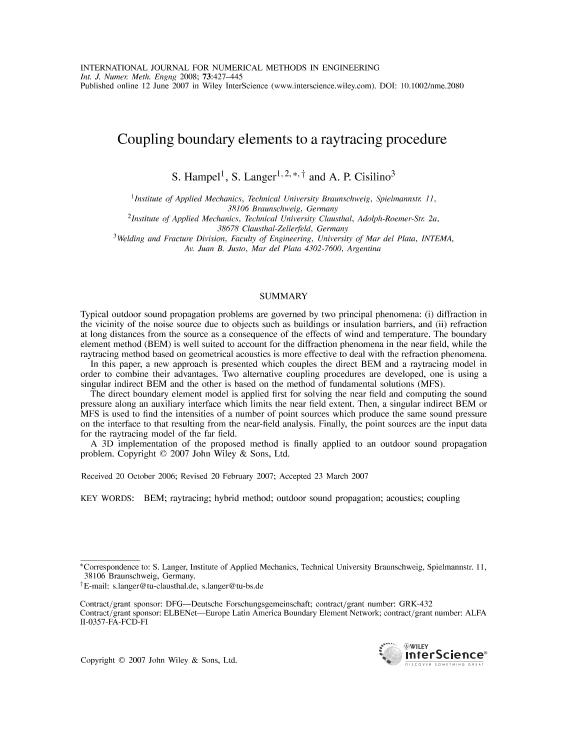Artículo
Coupling boundary elements to a raytracing procedure
Fecha de publicación:
01/2008
Editorial:
John Wiley & Sons Ltd
Revista:
International Journal for Numerical Methods in Engineering
ISSN:
0029-5981
Idioma:
Inglés
Tipo de recurso:
Artículo publicado
Clasificación temática:
Resumen
Typical outdoor sound propagation problems are governed by two principal phenomena: (i) diffraction in the vicinity of the noise source due to objects such as buildings or insulation barriers, and (ii) refraction at long distances from the source as a consequence of the effects of wind and temperature. The boundary element method (BEM) is well suited to account for the diffraction phenomena in the near field, while the raytracing method based on geometrical acoustics is more effective to deal with the refraction phenomena. In this paper, a new approach is presented which couples the direct BEM and a raytracing model in order to combine their advantages. Two alternative coupling procedures are developed, one is using a singular indirect BEM and the other is based on the method of fundamental solutions (MFS). The direct boundary element model is applied first for solving the near field and computing the sound pressure along an auxiliary interface which limits the near field extent. Then, a singular indirect BEM or MFS is used to find the intensities of a number of point sources which produce the same sound pressure on the interface to that resulting from the near-field analysis. Finally, the point sources are the input data for the raytracing model of the far field. A 3D implementation of the proposed method is finally applied to an outdoor sound propagation problem.
Palabras clave:
Acoustics
,
Bem
,
Coupling
,
Hybrid Method
,
Outdoor Sound Propagation
,
Raytracing
Archivos asociados
Licencia
Identificadores
Colecciones
Articulos(INTEMA)
Articulos de INST.DE INV.EN CIENCIA Y TECNOL.MATERIALES (I)
Articulos de INST.DE INV.EN CIENCIA Y TECNOL.MATERIALES (I)
Citación
Hampel, S.; Langer, S.; Cisilino, Adrian Pablo; Coupling boundary elements to a raytracing procedure; John Wiley & Sons Ltd; International Journal for Numerical Methods in Engineering; 73; 3; 1-2008; 427-445
Compartir
Altmétricas




